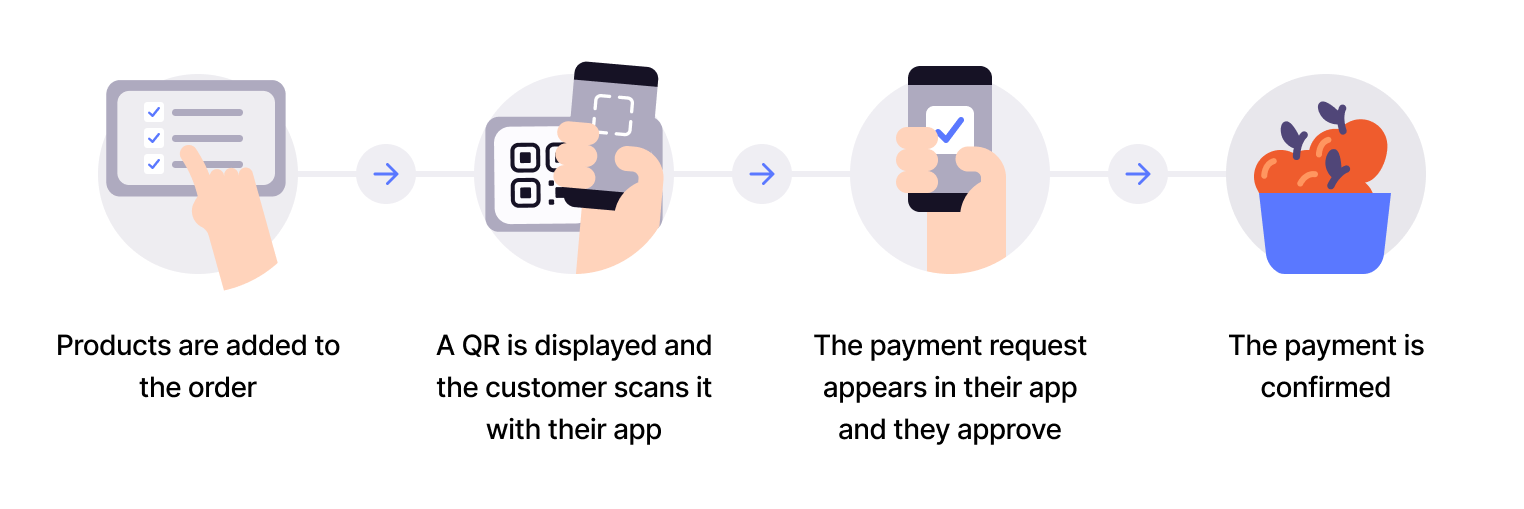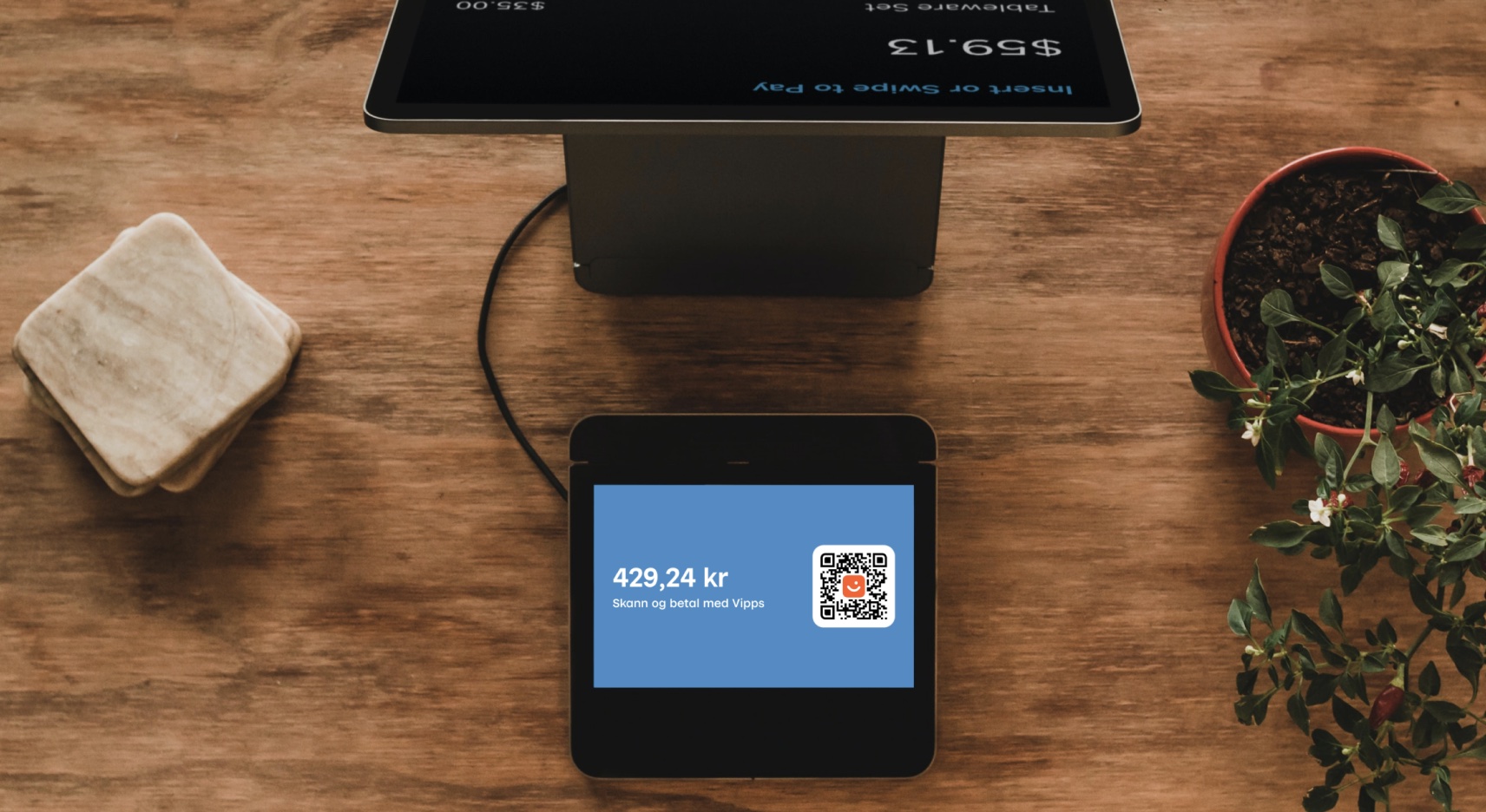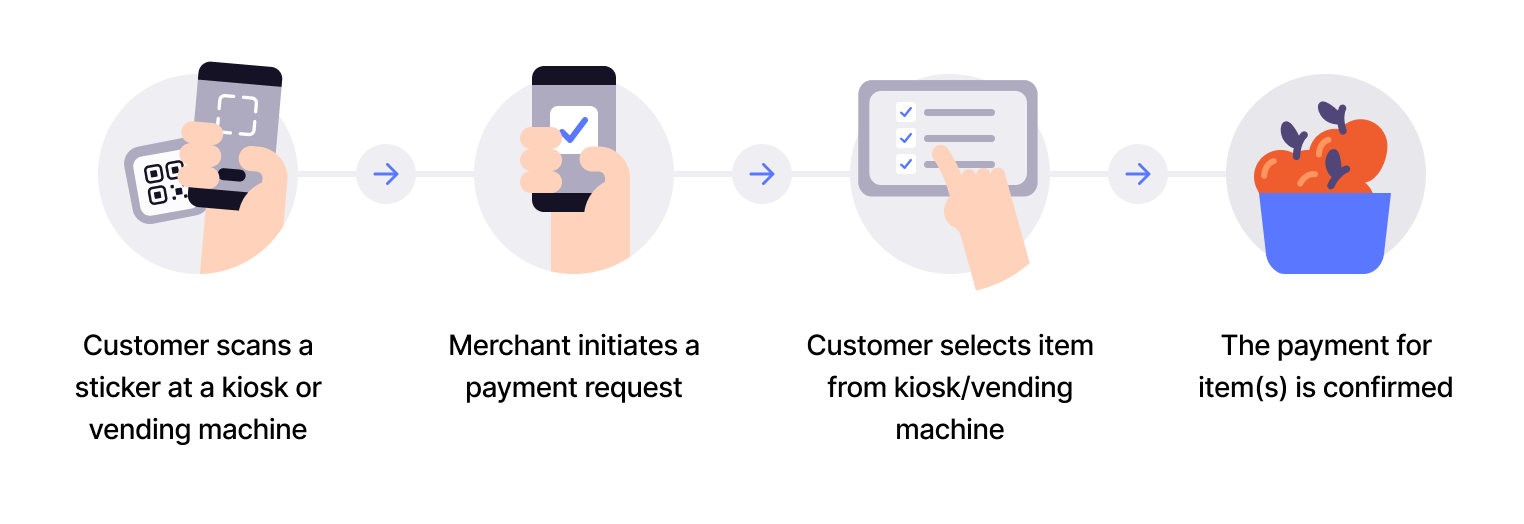In-person payments
Choose your scenario based on your point of sale setup:
- Customer-facing screen - You have a screen where you can display a dynamic QR code
- QR scanner - You have a scanner to read the customer's personal QR code
- POS - manual entry - You have a manned point of sale where the cashier enters the phone number
- Static QR - You have an unmanned point of sale like a vending machine or trust shop
- Customer-facing screen ⭐
- QR scanner
- POS-manual entry
- Static QR
Displaying one-time payment QRs
You have a screen at checkout that faces the customer (like a tablet, monitor, or payment terminal display).
You generate and display a unique QR code for each transaction. The customer scans it with their Vipps MobilePay app to pay.

- Generate QR - Create a dynamic QR code and payment request via ePayment API (details).
- Display QR - Show the QR code on the customer-facing screen.

- Customer scans and authorizes - Customer scans QR and approves payment in their app.
- Capture payment - Confirm the transaction is complete.
View sequence diagram
Dynamic QR directing to the app
Scanning the customer's personal QR code
You have a QR scanner at your checkout (the kind that can scan codes from a phone screen).
The customer opens their personal QR code in the Vipps MobilePay app, you scan it to identify them, then send the payment request to their app.

- Register products - Add items to the POS system.
- Scan customer's QR - Scan their personal QR code to identify the customer.
- Send payment request - Initiate payment using the ePayment API with
PUSH_MESSAGE. - Customer authorizes - Customer approves payment in their app.
- Capture payment - Confirm the transaction is complete.
View sequence diagram
QR scanner payment flow
Entering the phone number manually
You have a manned checkout where cashiers can enter information manually.
The cashier asks for the customer's phone number, enters it into your POS system, then sends the payment request to their Vipps MobilePay app.

- Register products - Add items to the POS system.
- Get customer phone - Manually enter the customer's phone number.
- Send payment request - Use the ePayment API to initiate payment with
PUSH_MESSAGE. - Customer authorizes - Customer approves payment in their app.
- Register payment - Update the POS system with payment status.
- Capture payment - Confirm the transaction is complete.
View sequence diagram
POS manual entry payment flow
Using static QRs
You have an unmanned location (like a vending machine, trust shop, or self-service kiosk) with no special hardware.
Choose between two types of static QR codes:
Merchant Callback QR
Display a printable static QR code that sends a callback to your system when scanned. Best for self-checkout, vending machines, or unmanned locations where you need to know when a customer is ready to pay.
When scanned with the Vipps MobilePay app, you receive a customer token via webhook. You then initiate a payment that reserves the price of the most expensive item, customer makes their selection, and you capture only the actual amount.

- Generate QR - Create a static QR code and display it near the checkout.
- Customer scans QR - Customer scans the static QR code with the Vipps MobilePay app.
- Callback received - Your system receives a webhook notification with a customer token.
- Initiate payment - Send payment request for the most expensive item's price via ePayment API.
- Customer authorizes - Customer approves the payment in their app.
- Customer selects product - Customer makes their selection on the vending machine.
- Partial capture - Capture only the actual amount for the selected product.
- Cancel remaining - Release the remaining authorized amount.
View sequence diagram
Static QR directing to the Vipps MobilePay app
Merchant Redirect QR
Display a printable static QR code that redirects customers to your website when scanned. Works with any phone camera - the Vipps MobilePay app is not required. The QR never expires.
Use this when you want to direct customers to your website for product selection and payment.

- Create a QR code - Display a Merchant redirect QR code.
- Customer scans QR - Customer scans the static QR code with their phone camera.
- Redirect to website - Customer is taken directly to your website.
- Customer shops - Customer browses your website and selects products.
- Customer initiates payment - Customer chooses to pay with Vipps MobilePay.
- Send payment request - Merchant initiates payment through the ePayment API.
- Customer authorizes - Customer approves payment in their app.
- Capture payment - Confirm the transaction is complete.
View sequence diagram
Static QR directing to the merchant site
Technical details
Dynamic QR codes (customer-facing screen):
- How to make one-time payment QRs - Visual walkthrough of the customer experience
- How the QR API works with one-time payment - Detailed QR flow with QR API
Personal QR codes (QR scanner):
- How ePayment works in the store - Visual walkthrough of the customer experience
- Personal QR feature - Implementation guide for personal QR payments
Manual entry (POS):
- How ePayment works in the store - Visual walkthrough of the customer experience
Static QR codes (unmanned locations):
- How the QR API works with merchant callback - Visual walkthrough of callback QR flow
- How the QR API works with merchant redirect - Visual walkthrough of redirect QR flow
- Subscribe to
user.checked-in.v1webhook - Receive scan notifications for callback QRs